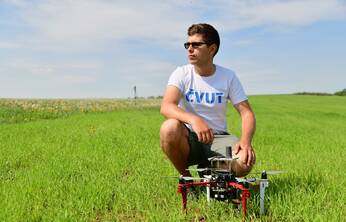Scientists from the Multi-robot Systems Group at the Faculty of Electrical Engineering at CTU have been working for three years to develop a solution to help rescuers in similar incidents and accidents. The RaDron research project combined the capabilities of small unmanned aircraft (drones) and miniature radioactive radiation detectors. Detectors for fast detection of static or moving gamma radiation sources are integrated into small and flexible drones, which are controlled autonomously with the help of artificial intelligence, without the intervention of a human operator.
"Compared to current systems, drones can benefit from the advantageous combination of small size and high mobility, so that the source can be searched for very quickly even in difficult to access terrain. Drones equipped with detection technology capable of capturing and identifying individual radiation particles in real time make it possible to locate the source of radiation significantly more efficiently than is possible today, at an incomparably lower acquisition cost. In addition, we have demonstrated in a successfully completed project that the possibility of deploying a team of cooperating drones makes it possible to accurately locate even a moving radiation source, which is very difficult with current technology," says Assoc. Martin Saska, Head of the Multi-robot Systems Group at the Department of Cybernetics, Faculty of Electrical Engineering, CTU in Prague.
According to Martin Saska, the device will be used by the police, army, rescue forces or nuclear power plants, especially in monitoring security risks - checks at borders, ports, airports, accident sites, municipal waste repositories, and regular deliveries of isotopes for nuclear medicine. The drones' great manoeuvrability and ability to quickly survey large areas make them predominantly applicable to security incidents such as the one now taking place in Western Australia.
A prototype of the device developed in cooperation with Czech companies within the framework of the TAČR project is already finished and ready for deployment at the end customer. Academics from FEE CTU are able to customize the drone software (autonomous search and source identification by one or a group of drones), while ADVACAM s.r.o and Fly4Future s.r.o will prepare a specific application of the Timepix ionizing radiation detector drone tailored for the end user of the system. The ADVACAM detector, which was developed in cooperation with CERN, is also a supplier to the US NASA. The offered drone is available in a variant for outdoor flight with GPS or in a variant for deployment indoors and near obstacles where GPS signal is not available and the drone uses unique software developed by scientists from the Faculty of Electrical Engineering of CTU for its navigation.
The Multi-robot Systems Group (MRS), operating at the Department of Cybernetics of the Faculty of Electrical Engineering of the Czech Technical University in Prague, uses a globally unique technology of very precise helicopter control, which proves to be significantly the most reliable and successful of all competing solutions. The ability to fly very accurately, and therefore safely, is crucial for deployment in a wide range of situations, especially near obstacles, in confined spaces and building interiors.
The team has made significant progress in the development of these technologies over several years of intensive research in collaboration with the world's leading laboratories. Today's drones can move autonomously along a predetermined safe route while responding to unexpected obstacles. The group flight and stabilization capabilities of low-flying drones are already being tested by researchers from Charles Square in the areas of searching and rescuing people in inaccessible terrains underground or in the desert, mapping historical interiors or monitoring power line poles, among others.
The identification of a radioactive source is captured in a video by the MRS FEE CTU.




